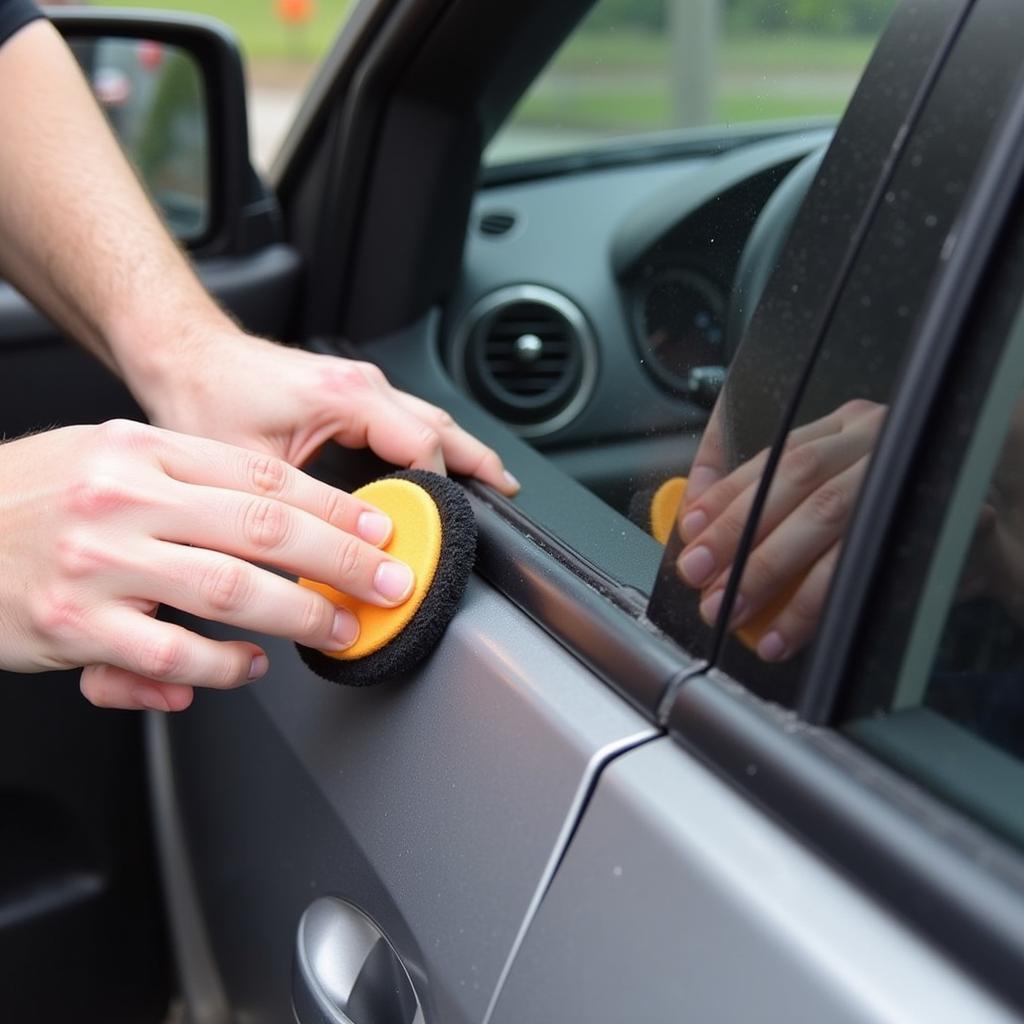Car window rubber, also known as window weatherstripping, plays a vital role in keeping your car’s interior comfortable and protected from the elements. Over time, exposure to sun, rain, and temperature changes can cause the rubber to crack, tear, or become brittle, leading to leaks, wind noise, and reduced efficiency of your car’s heating and cooling system. Fortunately, repairing car window rubber is a manageable DIY task that can save you money and extend the life of your vehicle.
Identifying the Problem: When to Repair Car Window Rubber
Before diving into the repair process, it’s crucial to determine the extent of the damage and whether a simple fix will suffice or a complete replacement is necessary. Look out for these telltale signs:
- Visual cues: Inspect the rubber seals around your car windows for any visible cracks, tears, or gaps. Pay close attention to the corners, which tend to wear out faster.
- Water leaks: If you notice water seeping in around your windows during rain or car washes, it’s a clear indication of compromised window rubber seals.
- Increased wind noise: Worn-out rubber seals can create gaps that allow wind to enter the cabin, resulting in annoying whistling or roaring sounds while driving at higher speeds.
- Difficulty closing windows: If you find it hard to shut your car windows completely or notice them rattling, it could be due to deformed or shrunken rubber seals.
Tools and Materials for Repairing Car Window Rubber
Having the right tools and materials at hand will make the repair process smoother and more efficient. Here’s a list of essential items you’ll need:
- Cleaning supplies: Gather a bucket of warm soapy water, a microfiber cloth or sponge, and rubbing alcohol.
- Rubber conditioner or sealant: Choose a high-quality rubber conditioner specifically designed for automotive use. Alternatively, opt for a specialized rubber sealant for more severe damage.
- Applicator tools: Depending on the type of conditioner or sealant you choose, you might need a brush, foam applicator, or a caulking gun.
- Masking tape: Use masking tape to protect the surrounding areas of your car’s paint and glass from accidental contact with the conditioner or sealant.
- Utility knife or scissors: These will come in handy if you need to trim any excess rubber or remove severely damaged sections.
Step-by-Step Guide to Repairing Car Window Rubber
Follow these detailed steps to effectively repair your car window rubber and restore its functionality:
- Clean the rubber seals thoroughly: Begin by washing the rubber seals with warm soapy water and a microfiber cloth or sponge to remove dirt, grime, and debris. Rinse well and dry completely.
- Prepare the surface: Once dry, use rubbing alcohol to clean the rubber seals again. This will remove any remaining residue and ensure proper adhesion of the conditioner or sealant.
- Apply the rubber conditioner or sealant: Apply the chosen product according to the manufacturer’s instructions. If using a conditioner, massage it into the rubber thoroughly with a brush or foam applicator. For sealants, apply a thin, even bead along the length of the damaged area.
- Allow sufficient drying time: Let the conditioner or sealant dry completely as per the product’s guidelines. This usually takes a few hours, but it’s best to avoid touching or disturbing the repaired area during this time.
- Inspect and test: Once dry, inspect the repaired rubber seals for any missed spots or imperfections. Test the windows by opening and closing them several times to ensure a snug fit and proper sealing.
Prolonging the Life of Your Car Window Rubber
Prevention is key to maintaining the integrity of your car window rubber. By incorporating these simple practices into your car care routine, you can significantly extend their lifespan:
- Regular cleaning: Wash your car’s rubber seals with mild soap and water every time you wash your car. This will prevent dirt and grime buildup that can accelerate wear and tear.
- Apply rubber protectant: Use a dedicated rubber protectant formulated for automotive use every few months to keep the rubber seals supple and prevent drying, cracking, and fading.
- Avoid parking in direct sunlight: Prolonged exposure to UV rays can damage the rubber over time. If possible, park your car in a shaded area or use a car cover.
- Address minor issues promptly: Don’t ignore early signs of wear and tear. Addressing minor cracks or dryness promptly can prevent more significant damage down the line.
When to Consider Replacing Car Window Rubber
While repairing minor damage to car window rubber is often feasible, there are instances where replacement becomes necessary:
- Extensive damage: If the rubber seals are severely cracked, torn, or brittle, repair might not be effective, and replacement would be the more practical solution.
- Age of the rubber: Even with proper care, car window rubber has a limited lifespan. Over time, it naturally deteriorates and loses its elasticity, necessitating replacement.
- Persistent leaks or noise: If you’ve attempted repairs but still experience water leaks or excessive wind noise, it’s a sign that the rubber seals are beyond repair.
Seeking Professional Help
While repairing car window rubber is generally a DIY-friendly task, don’t hesitate to seek professional assistance from a qualified mechanic or auto body shop if:
- You’re uncomfortable tackling the repair yourself.
- The damage is extensive or you’re unsure about the right course of action.
- You’ve attempted repairs but haven’t achieved satisfactory results.
Conclusion
Repairing car window rubber is a crucial aspect of car maintenance that can save you from costly repairs and ensure a comfortable and quiet ride. By understanding the signs of damage, following the repair steps diligently, and implementing preventive measures, you can prolong the life of your car window rubber and keep your vehicle in optimal condition. Remember, a little care and attention can go a long way in maintaining the integrity and longevity of your car’s components.
FAQs
Q: Can I use household products like WD-40 or petroleum jelly to repair car window rubber?
A: While these products might seem like quick fixes, they can actually damage the rubber in the long run. It’s best to stick to specialized rubber conditioners or sealants formulated for automotive use.
Q: How often should I replace my car window rubber?
A: There’s no set timeframe for replacement as it depends on factors like climate, usage, and maintenance. However, inspecting the rubber seals annually and replacing them every 5-7 years or sooner if significant damage is observed is a good rule of thumb.
Q: Can I drive my car with damaged car window rubber?
A: While driving with minor damage might seem harmless, it can worsen the problem over time, leading to water leaks, wind noise, and potential damage to your car’s interior.
Q: How much does it cost to replace car window rubber professionally?
A: The cost can vary depending on your car’s make and model and the extent of the replacement required. It’s best to get a quote from a trusted mechanic or auto body shop for an accurate estimate.
For more information on car window rubber seal repair, check out our comprehensive guide: how to repair car window rubber seal. You can also find valuable tips and insights on repair car window rubber seal and car window rubber seal repair.
If you’re looking for a reliable repair kit, we recommend the Blueshine car window rubber door seal repair kit. For those in the Mesa area, we highly recommend checking out car window rubber seal repair Mesa for top-notch services.
Need further assistance with your car window rubber repair?
Contact our team of experts through WhatsApp: +1(641)206-8880 or Email: [email protected]. We are available 24/7 to answer your questions and provide guidance.


